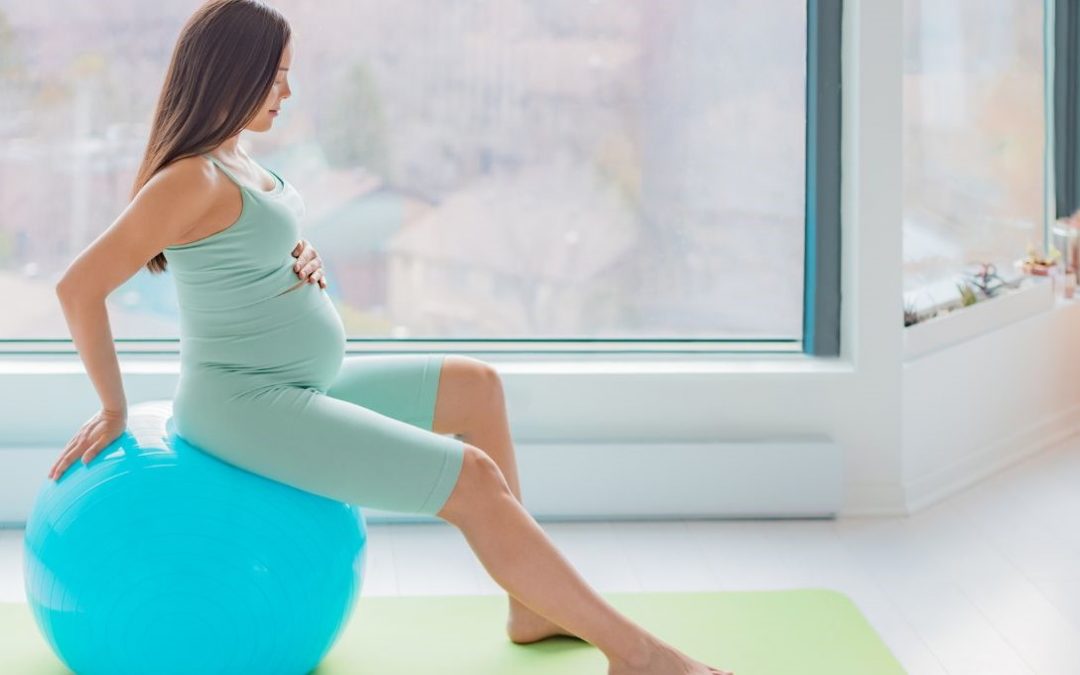If you come to my Pregnancy Power-Up class, the first thing I’ll tell you (after ‘don’t bump the bump’) is that my goal is for you to keep exercising right up till your baby is born.
For a lot of women that’s a fun, empowering, joyful thing to do. For the women who don’t keep active, one of the main reasons is pelvic girdle pain.
The Royal College of Obstetricians and Gynecologists says that Pelvic Girdle Pain (PGP) affects 1 in five pregnant women, although other sources say the number is higher.
It’s a pain which often persists, and which can be felt around your pelvis (hips, glutes, thighs, coccyx, lower back, hip flexors, inner thighs, groin, pubic region) and might show up when you:
- Walk down or up stairs
- Turn over in bed
- Stand on one leg
- Uncross your legs when sitting
There is no definitive reason why some women get PGP and some don’t, but we do know it isn’t caused by a ‘weak core’ or an ‘unstable pelvis’ – your pelvis is incredibly stable and pain doesn’t mean you’re fragile!
PGP is linked to stress, anxiety, poor mental health and feelings of depression, and I don’t think that’s a surprise.
The pelvis is where we keep emotions, as well as where we grow babies.
Consider the many things women are encouraged to feel shameful about. Periods, sex, sexual abuse, body hair, physical pleasure – they’re all about the pelvis.
The body remembers when we are shamed for these things and a lifetime of stress, sadness or trauma can build up in the pelvic region.
Stress leads to tension in the muscles which leads to pain.
The answer to pelvic pain is rarely exercise or getting stronger – it is more likely to be firstly about softening, releasing, melting and letting go.
That’s why getting comfortable helps alleviate pain, and why massage – either by a massage therapist like me, or by yourself with a massage ball or foam roller, can be very helpful.
Here are my top tips for PGP. I hope you’ll find one or more that will help you.
- Sleep on a softer surface. This might be on top of duvets, or investing in a memory foam mattress topper.
- Always sit with knees higher than hips
- If exercise helps, do it. If it makes it worse, don’t do it.
- Try to relax. Your pelvis is not unstable or out of alignment, and pain doesn’t mean you’re fragile. Worry doesn’t help and only breeds worry.
- Taping or support belts can help. If they’re going to work for you, the effects will be instant.
- Sit on a gym ball (aka swiss ball or birthing ball). It keeps you upright, encourages you to move while you sit, and keeps you in that important hips-above-knees position.
- Keep your knees together when you can. If you’re in a car, sit on a slippy plastic bag so you can swing your legs out of the door with your knees together.
- Support your sleeping with lots of cushions and pillows. These will also be helpful when feeding a baby, so don’t be scared to invest a little. Try a rolled-up towel between your knees.
- Train your glutes. At the least, squeeze your butt muscles regularly throughout the day.
- Do pelvic floor muscle exercise – gently closing and lifting the pelvic floor; then –
- Spend an equal amount of time softening and releasing your pelvic floor.
- See a women’s health physiotherapist. These specialists are excellent at diagnosing exactly what’s causing the problem and which muscles are too tight. Your GP can refer you but it might take a while, so consider looking for a private WHP in your area.
- Get a therapeutic pregnancy massage. Rather than a spa-style relaxation massage, check that your therapist can work specifically to help alleviate your PGP.
- Soften tight thighs (quadriceps) by using a foam roller, wine bottle or rolling pin gently on them. Be kind to yourself, don’t press so hard it hurts.
- Soften your gluteals. Using a massage ball or fairly firm dog ball, massage your own butt. One of my favourite moves: sandwich the ball between your bottom and a wall, and gently lean onto the ball. Move around, looking for tight areas and allowing them to soften under the ball. Keep moving around, rather than leaning in hard.
- Downtrain your muscles. Spend at least 10 minutes in as comfy a position as you can, doing this: inhale so your tummy expands. Exhale and soften your body. With each subsequent exhale, imagine you’re sending the breath out of your body via your pelvic floor; next exhale – out through your butt muscles; next exhale – out through your thighs. The more gently you can visualise these ‘body exhales’, the more you’ll generate softness and relaxation in the muscles.
If you’d like to book a massage with me, focussing on helping you with pelvic girdle pain, my massage clinic is on Saturdays in Leith, Edinburgh. You can see what’s available on my booking page.


